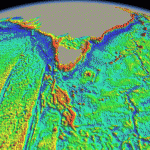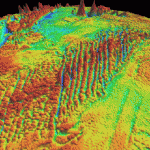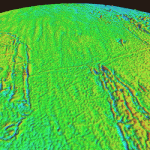![]() During the Early Cretaceous Australia’s eastward passage over sinking subducted slabs induced widespread dynamic subsidence and formation of a large eperiogenic sea in the eastern interior. Despite evidence for convergence between Australia and the paleo-Pacific, the subduction zone location has been poorly constrained. Using coupled plate tectonic-mantle convection models, we test two end-member scenarios, one with subduction directly east of Australia’s reconstructed continental margin, and a second with subduction translated ~1000 km east, implying the existence of a back-arc basin. Our models incorporate a rheological model for the mantle and lithosphere, plate motions since 140 Ma and evolving plate boundaries. While mantle rheology affects the magnitude of surface vertical motions, timing of uplift and subsidence depends on plate boundary geometries and kinematics. … Read more…
During the Early Cretaceous Australia’s eastward passage over sinking subducted slabs induced widespread dynamic subsidence and formation of a large eperiogenic sea in the eastern interior. Despite evidence for convergence between Australia and the paleo-Pacific, the subduction zone location has been poorly constrained. Using coupled plate tectonic-mantle convection models, we test two end-member scenarios, one with subduction directly east of Australia’s reconstructed continental margin, and a second with subduction translated ~1000 km east, implying the existence of a back-arc basin. Our models incorporate a rheological model for the mantle and lithosphere, plate motions since 140 Ma and evolving plate boundaries. While mantle rheology affects the magnitude of surface vertical motions, timing of uplift and subsidence depends on plate boundary geometries and kinematics. … Read more…
Prof Dietmar Müller
Phone: +61 2 9351 4255
Fax: +61 2 9351 3644
School of Geosciences
The University of Sydney
Sydney, NSW 2006
Australia
View Dietmar's Sydney Uni page
See below for EarthByte content related to Dietmar.
High resolution reconstruction of the Central and Eastern Indian Ocean
Project Summary
Plate reconstruction models for the rifting and separation of Gondwanaland’s conjugate margins continue to be poorly constrained. We propose to develop a new, high-resolution plate model for the central and eastern Indian ocean by synthesizing old and new geological and geophysical data utilizing combined French and Australian advanced software for magnetic anomaly modeling and plate tectonic reconstructions. We will test alternative continental fit reconstruction hypotheses by using a variety of reconstructed data sets. Such a joint research is timely, as the Indian Ocean continental margins become the focus of intense oil and gas exploration. … Read more…
Dietmar Müller awarded Mercator Professor Fellowship
Congratulations to Dietmar Müller who was awarded the Forschungsgemeinschaft (German Research Foundation) Mercator Professor Fellowship at the Ludwig-Maximilians-Universität München, Germany).
The subduction reference framework: Unravelling the causes of long-term sea-level change
Project Summary
Sea level has fluctuated by up to 300 m through geological time, creating vast sedimentary basins and associated natural resources. We will use Earth’s subduction history as imaged by seismic tomography to establish a subduction reference framework for the past 200 million years, tracking all tectonic plates in both latitude and longitude. 4D numerical mantle-plate tectonic simulations (3D plus time) will reconstruct how the recycling of old, cold oceanic plates into the mantle have influenced surface topography and sea-level change since the breakup of the supercontinent Pangaea. … Read more…
Integration of plate kinematic reconstructions in geodynamic models of mantle convection
Project Summary
Despite more than 30 years of plate tectonics research, we still do not know exactly what drives the plates or controls the time-dependence of mantle convection. Plate motions are linked to processes in the deeper Earth interior by complex, enigmatic cause-and-effect relationships. While mantle convection is generally accepted as the underlying cause of plate motions, the geometry of mantle flow and its relation to plate motions remains poorly understood. As plate tectonics is the Earth Science paradigm, breakthroughs in this field affect understanding of all branches of Earth Science including formation and distribution of natural resources, long-term climate change and natural hazards. … Read more…
Dietmar Müller awarded Australian Laureate Fellow
Congratulations to Prof. Dietmar Müller who has been awarded one of only 15 Australian Laureate Fellowships.
How supercontinents and superoceans affect seafloor roughness
Seafloor roughness varies considerably across the world’s ocean basins and is fundamental to controlling the circulation and mixing of heat in the ocean and dissipating eddy kinetic energy. Models derived from analyses of active mid-ocean ridges suggest that ocean floor roughness depends on seafloor spreading rates, with rougher basement forming below a half-spreading rate threshold of 30-35 mm/yr, as well as on the local interaction of mid-ocean ridges with mantle plumes or cold-spots.
… Read more…
Age and Bathymetry of the World’s Ocean Crust for the last 140 million years
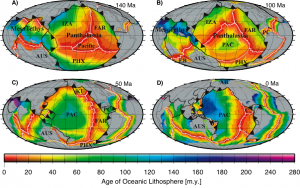 Reconstructing vanished oceans
Reconstructing vanished oceans
We establish the locations and geometry of mid ocean ridges through time on the basis of marine magnetic anomaly identifications, geological information such as paleomagnetic data from terranes and microcontinents, especially in the Tethys Ocean, mid-oceanic ridge subduction events and the rules of plate tectonics. Based on a global set of tectonic plate rotations we construct a set of refined seafloor isochrons following the interpolation technique outlined by Müller et al. (1997; 2008) but including a multitude of additional data. … Read more…
Dietmar Müller awarded top reviewer in 2008
Congratulations to Dietmar Müller for being awarded top reviewer in 2008 for exceptional contribution to the quality of Tectonophysicsî by Elsevier, Amsterdam (The Netherlands), Publisher of Tectonophysics. Well done Dietmar!
Global subduction and back-arc basin grids and data
Please Note: These age grids are now outdated. Please see the agegrids available from the Müller et al. 2013 study on Ocean Chemistry at the Seawater chemistry driven by supercontinent assembly, break-up and dispersal resource page.
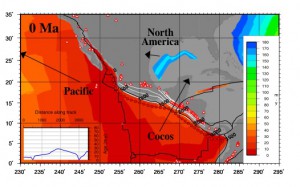 Downloads
Downloads
Download global subduction age grid images via FTP here – tgz file
Download global subduction parameter dataset via FTP here – tgz file
… Read more…
Underworld
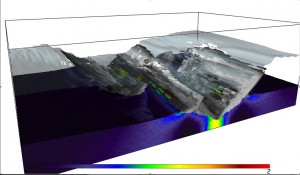 Underworld is a StGermain parallel modelling framework Geoscience research code, which utilises a Lagrangian particle-in-cell finite element scheme (the prototype of which is the Ellipsis code), visualised using gLucifer.
Underworld is a StGermain parallel modelling framework Geoscience research code, which utilises a Lagrangian particle-in-cell finite element scheme (the prototype of which is the Ellipsis code), visualised using gLucifer.
Dietmar Müller wins David I Groves Award
Congratulations to Dietmar Müller for winning the David I Groves Award for the best paper published by a junior author in the Australian Journal of Earth Sciences (Joint Award).
Dietmar Müller elected as Fellow of AGU
Congratulations to Dietmar Müller who has been elected as a Fellow of the American Geophysical Union. Dietmar will be attending a ceremony at the AGU Spring Meeting in Baltimore later this year for the presentation of the fellowship certificate.
Integrating global multidimensional datasets to underpin subduction process modelling during the past 60 million years
Project Report
Understanding the initiation and processes governing subduction remains one of the greatest challenges in geodynamics. Subduction processes affect every aspect of the Earth system, from its control on the thermal and chemical state of the mantle, to its recycling of oceanic lithosphere, sediments, water and volatiles, to its affect on the atmosphere, hydrosphere, biosphere and solid Earth through earthquakes and volcanic eruptions. Moreover, subduction is generally agreed to be one of the primary driving forces of plate tectonics and mantle convection through slab pull and the addition of raw materials into the mantle. … Read more…
Frontier Science and Exploration: The Arctic and Atlantic
Funding Agency Norwegian Research Council and Statoil Linkage Grant 2004-2007 Project Participants Prof Trond Torsvik Dr N. Kusznir A/Prof Dietmar Müller Project Contact Prof Trond Torsvik A/Prof Dietmar Müller
Grid Infrastructure Development for APAC Geoscience and Earth System Projects
Funding Agency Australian Partnership of Advanced Computing 2004-2006 Project Participants A/Prof Dietmar Müller Dr Masahiro Takatsuka Publications Project Contact A/Prof Dietmar Müller
Constructing a tectonic framework for Ocean Drilling at high latitudes
Project Summary
Currently a major Ocean Drilling Program (ODP) campaign south of Australia is being carried out, comprising nine drilling legs. We propose to create a tectonic and paleogeographic framework for interpreting, modelling and synthesising these data. A joint analysis of Arctic and Antarctic regions will bring together a group of researchers from the Universities of Ottawa/Canada, California at San Diego/USA and Sydney to integrate data and models for the evolution of polar ocean basins and margins. The project will strengthen our ties with centres of excellence in polar geoscience and help to maximise the return for Australia’s investment in ODP. … Read more…
Tectonic Reactivation and Palaeo-Stresses (TRAPS)
An interdisciplinary collaborative research project. Strategic Partnership with Industry – Research and Training (SPIRT)
Sponsored By
Australian Research Council
BHP
Santos
Shell
Woodside
2001 Report … Read more…
Seafloor spreading around Australia
(a) Abstract
The Australian Plate has undergone major changes in plate boundary geometry and relative plate velocities since the breakup of Gondwanaland. We illustrate the history of seafloor spreading around Australia by reconstructing gridded ocean floor ages and plate boundary configurations in a fixed Australian reference frame. In the Argo Abyssal Plain, seafloor spreading started at M25 dated as 154.3 Ma Late Jurassic (Oxfordian). The onset of seafloor spreading west of Australia at ~136 Ma marks the breakup between Greater India and Australia. Roughly at the same time, long-lived subduction east of Australia ceased, probably due to subduction of the Phoenix-Pacific spreading ridge, changing this plate boundary to a transform margin. … Read more…
Numerical Modeling of Archean Tectonic Regimes by 2-Dimensional Finite Element Code
Project Summary
Many lines of evidence suggest that heat loss from the earth should have been significantly greater in the Archean. The presence of high temperature komatiites, greater radiogenic heat production and heat from the secular cooling of the earth all imply higher mantle temperatures in the Archean. However, these lines of evidence are difficult to reconcile with Archean metamorphic PT data, diamond thermobarometry, mantle xenoliths in kimberlites, the ominous lack of minimum melting granites and estimates for crustal thickness which all suggest that geothermal gradients in the Archean, at least on the continents, were not very different from today. This paradox presents problems for reconstructing Archean tectonic processes and environments. … Read more…
Seafloor imaging east and south of Australia
Project Summary
Data from three recent cruises on N.O. L’Atalante are used in collaboration with AGSO to use backscatter and bathymetry data for seafloor classification, and to reconstruct the tectonic and sedimentary history of selected areas, also based on 3.5 kHz, seismic reflection, gravity and magnetic data.
Sponsors
Australian Geological Survey Organization
Environment Australia … Read more…
The Mid-Cretaceous seafloor spreading pulse: fact or fiction?
Project Summary
A major debate in Geoscience is centred on the hypothesis that a massive pulse of rapid seafloor spreading occurred during the mid-Cretaceous (~120-80 Ma). It has been suggested that such a pulse caused prolonged magnetic field stability, large igneous provinces, a sea-level highstand, variations in atmospheric CO2 and anoxia, but doubts have been raised about its existence. We propose to test this hypothesis by creating complete palaeo-seafloor age grids for the last 130 m.y. They will serve as input for 3-D spherical convection models, whose output will be groundtruthed by plate kinematics, results from mantle tomography and by the uplift-subsidence history of cratons. … Read more…


